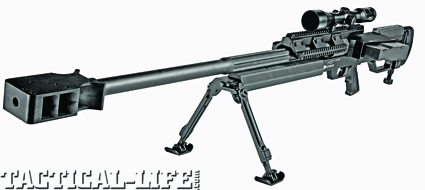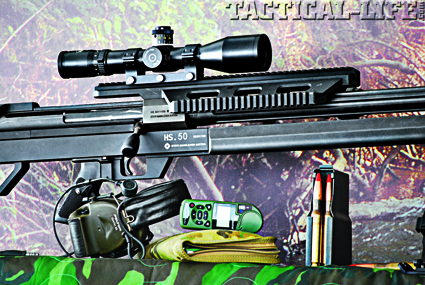Fifty shooting dictates the need for some specialized equipment such as PELTOR XS electronic ear protection, KESTREL 4500NV weather station a modular sniper data book. Without them you will not hit the target reliably and soon be deaf.
As a Tactical Weapons European correspondent who specializes in long-range target interdiction and who was familiar with the HS-50 rifles, I was asked to give TW an exclusive test fire of this weapons system.
As a professional long-range shooter, engaging targets that I can barely see is what interests me. How good a precision rifle is depends on how accurately it can shoot at 1,000 yards and beyond.
Advertisement — Continue Reading Below
Several years ago we had the chance to test the single-shot Steyr HS-50 and it was impressive. It was very accurate and possessed a pleasing quality feel, but it was only a single-shot weapon. Not having a detachable magazine is a serious drawback for many tactical applications. For most applications, including competition shooting, having a magazine well will not degrade accuracy measurably, and a repeater design offers the advantage of faster follow-up shots. Thus the single-shot Steyr HS-50 was not at the top of my .50-caliber wish list, and I was not alone. The Austrian Jagdkommando SOG, who fields the HS-50 single-shot to their African EUFOR Chad/CAR UN mission operators, although pleased with the superior accuracy of the rifle, asked to have a repeater capability.
When I heard that Steyr was seriously considering adding a detachable magazine to its HS-50 I kept in contact with the factory for updates, and was pumped for an early opportunity to test fire the new repeater HS-50M1. Designed to shoot as far as the .50BMG 12.7x99mm cartridge will allow, with one of the longest barrels of any production .50-caliber rifle, the HS-50 can now be fed from a unique side-loading five-round magazine.
 The 59-inch long HS-50M1 can report for long-range anti-materiel and counter-sniping duties on today’s battlefields. The laser-engraved Steyr
The 59-inch long HS-50M1 can report for long-range anti-materiel and counter-sniping duties on today’s battlefields. The laser-engraved Steyr
logo on the mags bottom plate reflects highlights the new side-loading magazine. The action latch is a vertical polished steel bar that adds to the swift reloading process.
Advertisement — Continue Reading Below
Examining the rifle from the muzzle rearward, you will find a 35-inch long, heavy, fluted, forged steel barrel. It contributes most of the rifle’s weight, and that is a good sign. It has been my experience, and this is corroborated by Austrian SF snipers, that with it you can shoot the 661-grain Multipurpose “Raufoss” bullet at more than 3,000 fps. That is much more than the 2,850 fps you obtain from the standard 29-inch .50-caliber military barrels and gives you an edge, whether shooting a Taliban at over a mile away, or targets at a 1,000-yard FCSA (Fifty Caliber Shooting Association) competition. Running these numbers on a LoadBase 3.0 ballistic software was even more impressive. Those extra 100 yards of supersonic flight may not seem like a lot, but going from 1,600 to 1,700 yards is not only a matter of getting some extra range, it means that at 1,000 yards you need 3.5 MOA less elevation and get a half MOA less deflection from a 10 mph wind. And that is a lot less, as any long-range shooter worth his salt knows. Best of all, these higly impressive numbers reflect just the standard MK211 military ammunition, which is not loaded very hot. I can’t even begin to anticipate the bullet speed that competition reloaders will get from this barrel, but this could surely mean the difference between merely a good and a record 1,000-yard shot grouping. The numbers are even more impressive with RUAG AP 664-grain ammunition which is supersonic up to 2,150 yards.























